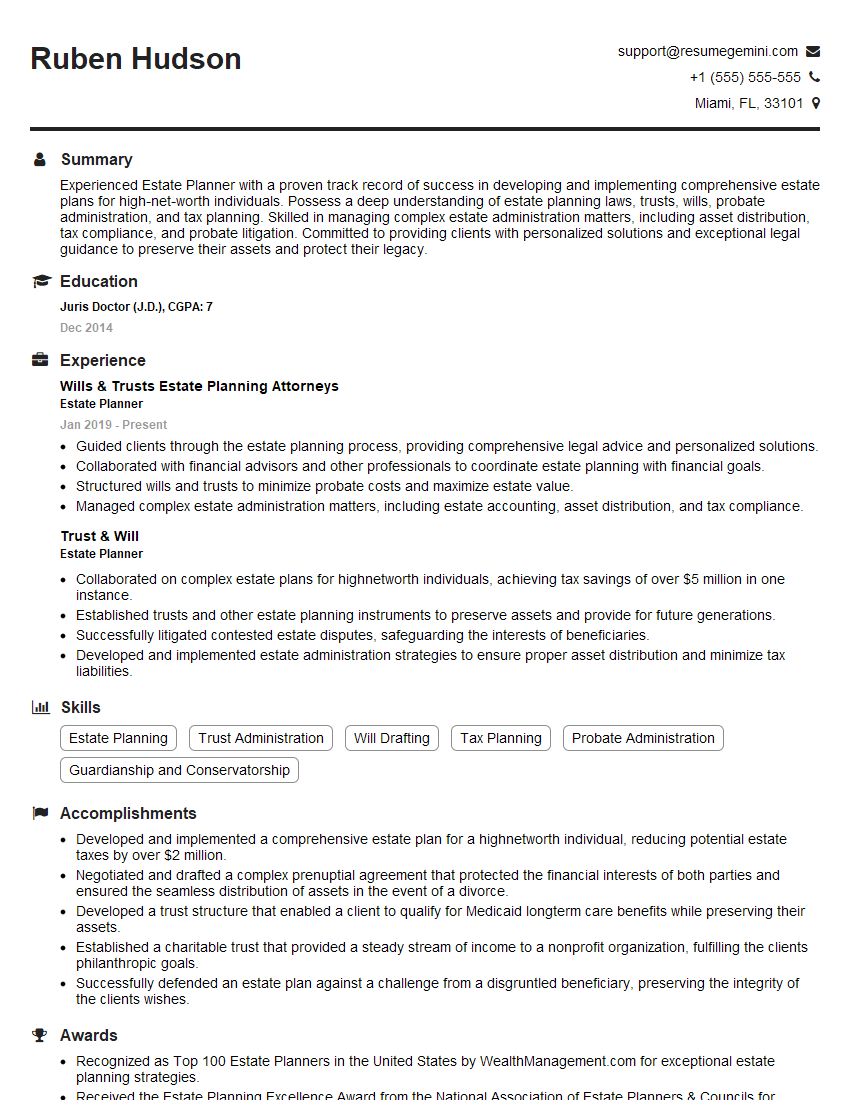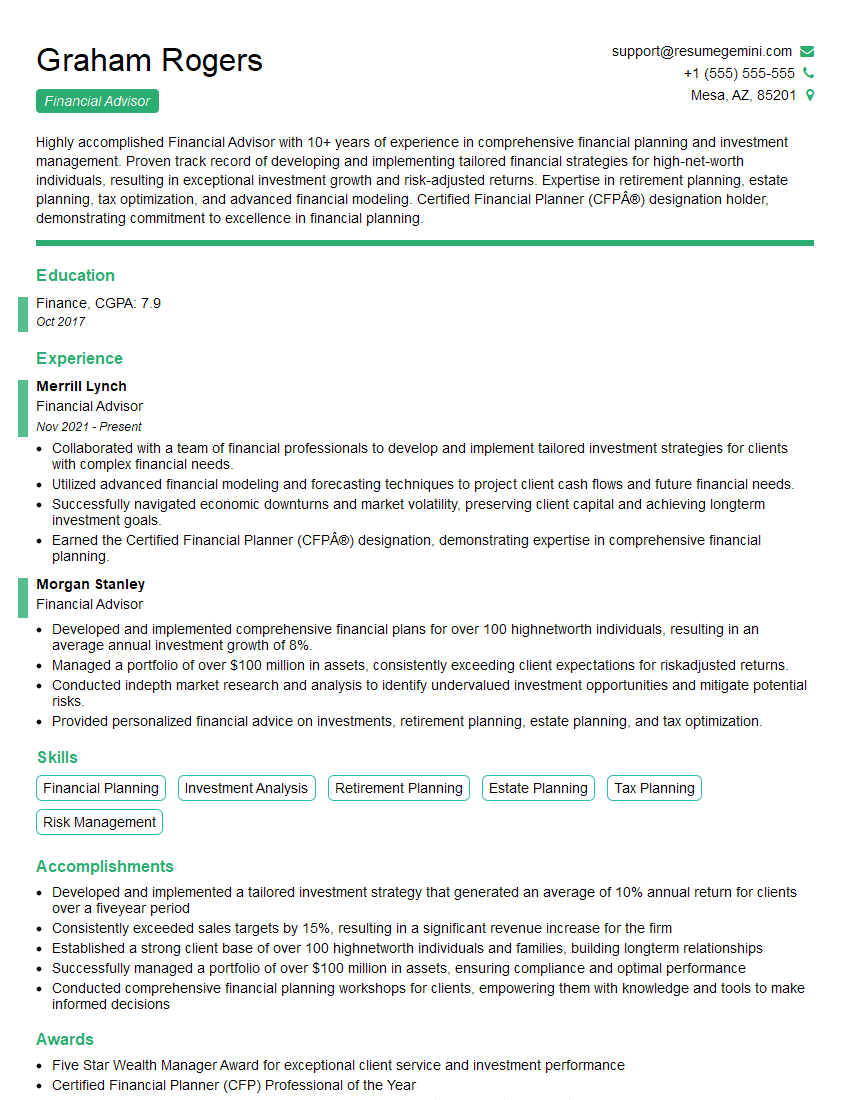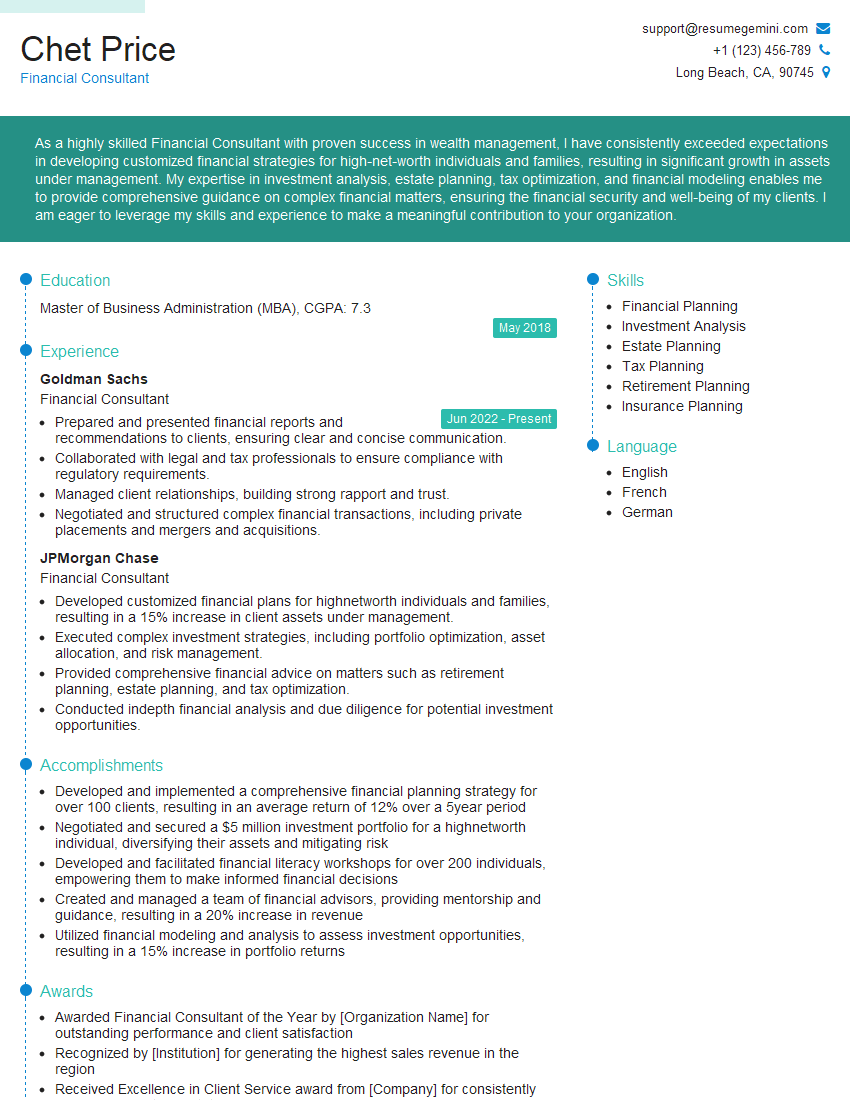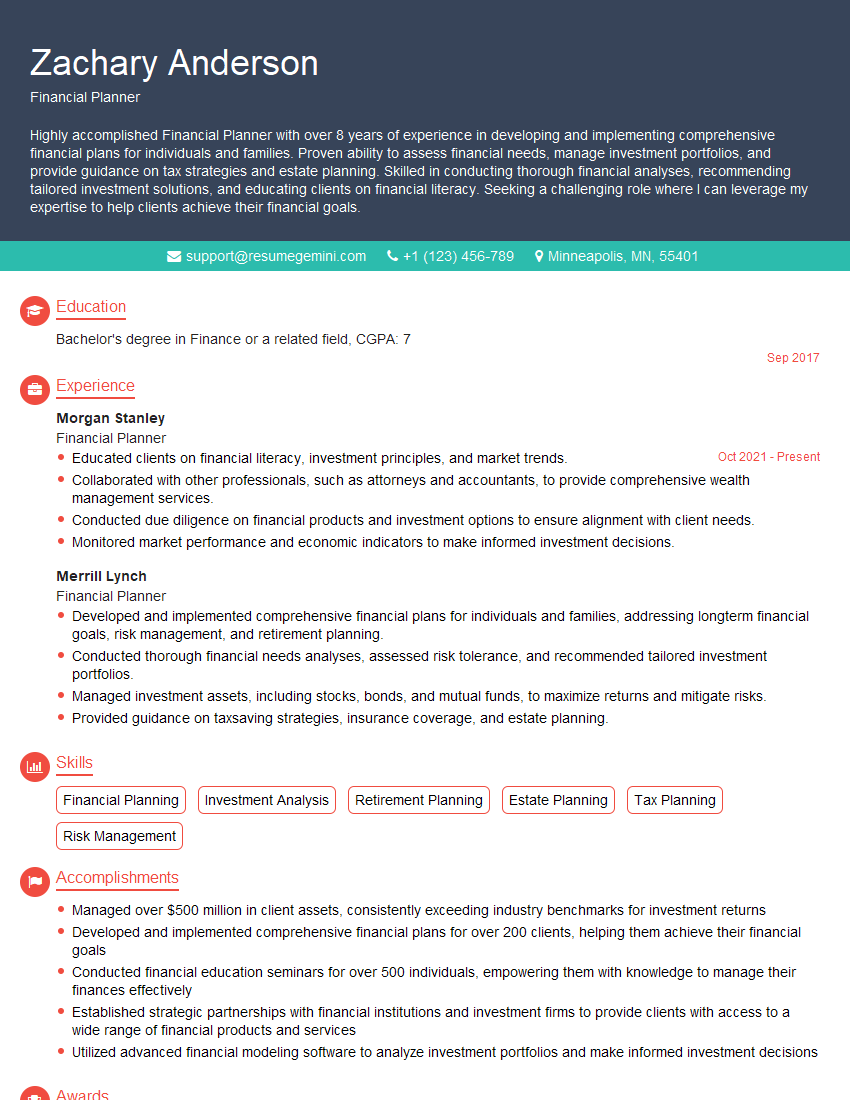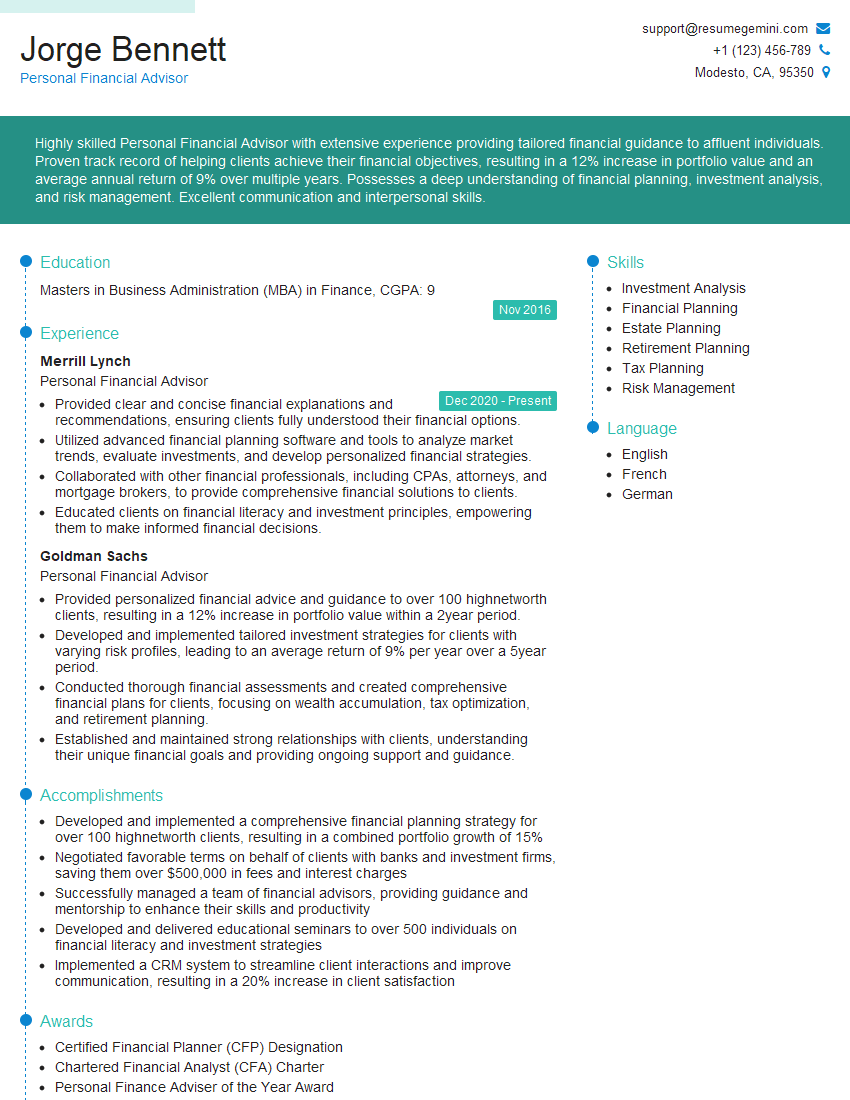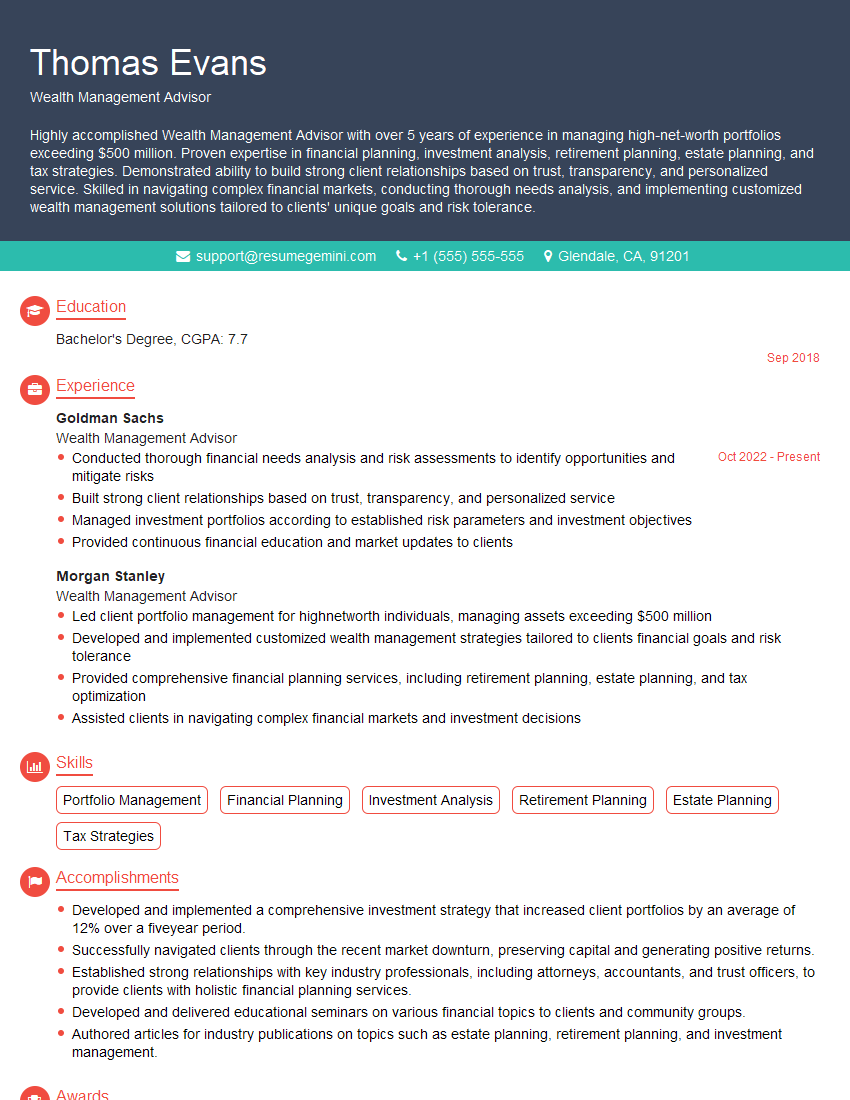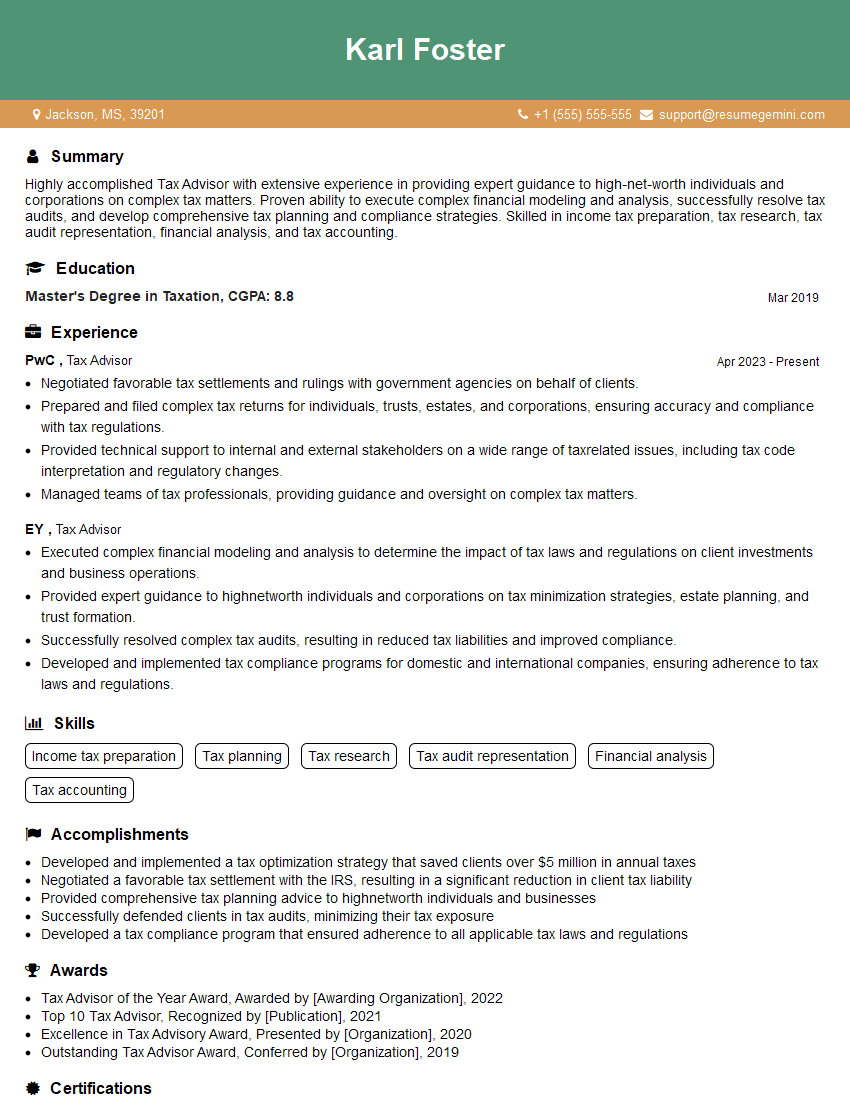The right preparation can turn an interview into an opportunity to showcase your expertise. This guide to National Association of Personal Financial Advisors (NAPFA) Membership interview questions is your ultimate resource, providing key insights and tips to help you ace your responses and stand out as a top candidate.
Questions Asked in National Association of Personal Financial Advisors (NAPFA) Membership Interview
Q 1. What are the core tenets of the NAPFA Code of Ethics and Standards of Conduct?
The NAPFA Code of Ethics and Standards of Conduct centers on the fiduciary duty to act in the best interest of clients. This means prioritizing client needs above all else, including the advisor’s own self-interest. Key tenets include:
- Impartiality and Objectivity: Advisors must provide unbiased advice, free from conflicts of interest.
- Integrity and Honesty: Complete transparency and truthful communication with clients are paramount.
- Diligence and Competence: Advisors must maintain the knowledge and skills necessary to provide competent advice, constantly updating their expertise.
- Confidentiality: Client information must be kept strictly confidential.
- Fairness and Disclosure: All fees, compensation arrangements, and potential conflicts must be clearly disclosed to clients.
Think of it as a doctor-patient relationship: a doctor’s primary concern is their patient’s well-being, and a NAPFA advisor’s primary concern is their client’s financial health.
Q 2. Explain the differences between fee-only and commission-based financial advisory models.
The core difference lies in how advisors are compensated:
- Fee-Only: Advisors charge clients a fee for their services, typically based on an hourly rate, retainer, or percentage of assets under management (AUM). There are no commissions or incentives to sell specific products, ensuring unbiased recommendations.
- Commission-Based: Advisors earn commissions from selling financial products, creating a potential conflict of interest. They may be incentivized to recommend products that generate higher commissions, even if they are not the best fit for the client.
Imagine choosing a car. A fee-only advisor is like a mechanic who objectively assesses your needs and recommends the best car for you, regardless of brand. A commission-based advisor is like a car salesman who might push a particular model, even if it’s not the perfect fit, because they earn more commission from it.
Q 3. How does NAPFA’s fiduciary responsibility differ from other advisory organizations?
NAPFA’s commitment to fiduciary duty is stricter than many other advisory organizations. While some organizations have ‘suitability’ standards, meaning they must recommend products ‘suitable’ for a client, NAPFA adheres to a higher standard—the fiduciary duty of acting in the client’s best interest. This means prioritizing the client’s needs above all others, including the advisor’s own financial gain. Many advisory organizations have broader definitions of ‘fiduciary’ or don’t enforce it consistently across their membership.
Consider this: a ‘suitable’ investment might be one that generates a decent return but carries high risk. A fiduciary would assess the client’s risk tolerance and financial goals and decide if that ‘suitable’ investment is actually in the client’s best interest.
Q 4. Describe your experience working within a fiduciary framework.
Throughout my career, operating within a fiduciary framework has been central to my practice. I’ve consistently prioritized client needs above all else. For instance, I had a client who was heavily invested in high-commission annuities. While I could have continued managing these (and earning fees from them), I assessed their suitability and risk profile, concluding they were unsuitable for his goals. I presented my findings and helped them transition to lower-cost, more appropriate investments, even though it meant a slight reduction in my income. This approach may lead to fewer short-term gains but builds stronger client relationships based on trust and long-term success.
Q 5. What is your understanding of NAPFA’s commitment to transparency and client disclosure?
NAPFA’s commitment to transparency and client disclosure is unwavering. This means proactively disclosing all fees, potential conflicts of interest, and the advisor’s compensation structure upfront. Clients must understand precisely how they are being charged and what services they are receiving in exchange. This includes details about investment strategies, product selection processes, and any potential relationships the advisor has with financial institutions. A client should never feel unsure about what they’re paying for or why a specific recommendation is being made.
A simple example: I always provide clients with a detailed fee schedule before starting any work. They have a full understanding of exactly what they’ll pay and when.
Q 6. How would you address a conflict of interest situation within the NAPFA framework?
Addressing a conflict of interest within the NAPFA framework involves several steps:
- Identification: The first step is identifying the potential conflict. This could involve receiving gifts from a product provider, owning stock in a company whose products you recommend, or having a personal stake in a client’s business.
- Disclosure: Full and transparent disclosure of the conflict to the client is essential. This ensures the client is aware of the potential influence on your advice.
- Mitigation: Steps must be taken to mitigate the conflict. This might involve recusal from advising on specific areas, seeking an independent opinion, or adjusting the compensation arrangement.
- Documentation: Meticulous documentation of the conflict, the disclosure, and the steps taken to mitigate it are crucial. This ensures accountability and protects both the advisor and the client.
For example, if I owned shares in a particular mutual fund company, I would disclose this fact to any clients before advising them on their mutual fund investments. I might then avoid recommending that specific company’s products altogether.
Q 7. Discuss your experience with financial planning software compatible with NAPFA’s requirements.
My experience with financial planning software compatible with NAPFA’s requirements is extensive. I utilize software that allows for thorough data aggregation, comprehensive financial planning, and detailed reporting features, all essential for maintaining the high standards expected by NAPFA. The software must allow me to generate client reports that clearly demonstrate the fee structure, investment strategies, and rationale behind recommendations. The software must also facilitate client communication and secure data storage, complying with all regulatory requirements. Specific software names are less important than its capacity to adhere to NAPFA’s principles. The software’s capacity for client communication, data security, and compliance are paramount.
Q 8. Explain your understanding of the regulatory environment surrounding NAPFA members.
NAPFA members operate under a rigorous regulatory environment, primarily focused on fiduciary duty and ethical conduct. This means we are legally obligated to act in the best interests of our clients, placing their needs above our own. This differs from a suitability standard, where advisors only need to ensure a recommendation is suitable, not necessarily the best option. Key regulations include, but are not limited to, state and federal securities laws, depending on the specific services offered. For example, advisors registered as investment advisors under the Investment Advisers Act of 1940 are subject to extensive regulations surrounding disclosure, record-keeping, and fiduciary responsibility. Many NAPFA members also hold other designations, such as Certified Financial Planner (CFP®), further adding to the regulatory framework they must adhere to. The emphasis is always on transparency and acting with the utmost integrity.
Q 9. How do you stay updated on the latest regulatory changes impacting NAPFA members?
Staying current on regulatory changes is paramount. I utilize several strategies: I actively subscribe to and regularly review publications from organizations like the SEC, FINRA, and my state’s securities regulator. NAPFA itself provides invaluable resources including newsletters, webinars, and continuing education courses specifically designed to keep members informed about changes and their implications. I attend industry conferences and workshops to engage with other professionals and hear directly from regulatory experts. Furthermore, I maintain membership in professional organizations beyond NAPFA, broadening my regulatory understanding. It’s a continuous process requiring dedication, but it’s essential for providing compliant and ethical advice.
Q 10. Describe your experience with various financial planning methodologies.
My experience encompasses various financial planning methodologies, adapting my approach to individual client situations. I’m proficient in traditional financial planning, emphasizing comprehensive goal setting, cash flow analysis, and retirement projections. I also incorporate behavioral finance principles, acknowledging the psychological aspects that influence financial decisions. For example, I’ll use different strategies depending on a client’s risk tolerance and time horizon, while keeping their life goals paramount. Goal-based planning, which uses a client’s goals as a measuring stick for investment strategy, is also frequently used. I’m familiar with holistic planning, bringing together all facets of a client’s finances into one cohesive plan, and also incorporate elements of tax-efficient planning where appropriate.
Q 11. How do you utilize NAPFA resources to enhance your client service?
NAPFA provides a wealth of resources that directly benefit my clients. The organization offers access to research reports, model portfolios, and compliance tools. These resources help me stay at the forefront of industry best practices, providing more informed recommendations. Additionally, NAPFA’s professional development opportunities enhance my skills and allow me to stay current with the latest financial planning strategies. For instance, the access to cutting-edge technology and software recommended by NAPFA improves my efficiency and the clarity of presentations for clients. The peer network within NAPFA is invaluable, allowing me to collaborate with other professionals and learn from their experiences, which ultimately improves my client service.
Q 12. How do you manage client expectations and address potential conflicts?
Managing client expectations and addressing potential conflicts starts with clear communication from the outset. My initial meetings involve a thorough discussion of my fee structure, services offered, and the limitations of financial planning. I use a comprehensive client agreement, meticulously outlining our working relationship. If conflicts arise, I address them proactively and transparently, utilizing a collaborative approach to find mutually acceptable solutions. For instance, if a client’s investment strategy changes due to unforeseen circumstances, I work with them to adjust the plan accordingly. Ethical considerations are paramount, and I am prepared to terminate a relationship if an irreconcilable conflict of interest arises.
Q 13. Explain your approach to developing comprehensive financial plans for diverse client needs.
My approach to developing financial plans is highly personalized, addressing the unique circumstances of each client. I begin with a thorough fact-finding process, including detailed interviews and data gathering. This enables me to understand their goals, risk tolerance, time horizon, and financial situation comprehensively. Using financial planning software, I create a customized plan addressing various aspects such as retirement planning, investment strategy, education funding, estate planning, and insurance needs. The plan isn’t static; we regularly review and adjust it based on life changes and market conditions. For example, I recently helped a young couple plan for both short-term (buying a house) and long-term (retirement) goals, balancing their need for higher-growth investments with the need for financial stability.
Q 14. What is your process for educating clients about fee structures and services provided?
Transparency regarding fees is essential. I clearly explain my fee structure during the initial consultation, providing a written fee schedule. This schedule details all charges, including hourly rates or percentage-based fees, and outlines what services are included. I use plain language, avoiding jargon, to ensure my clients fully understand how they are being charged. This often includes providing a comparison of different options, allowing them to make an informed choice. Regular communication about fees, including any adjustments, keeps the client informed and builds trust. The goal is to foster clarity and make sure the value proposition is consistently clear.
Q 15. Discuss your strategies for building and maintaining long-term client relationships.
Building and maintaining strong, long-term client relationships is paramount in financial advising. It’s not just about managing money; it’s about building trust and understanding a client’s life goals. My strategy is multifaceted and centers around consistent communication, personalized service, and proactive engagement.
Regular Communication: I schedule regular meetings—quarterly, at minimum—to review progress, address concerns, and proactively discuss market changes. I also utilize email and phone calls for quick updates and to respond to immediate questions. For example, I might send a brief market summary after a significant economic event to keep clients informed and demonstrate my ongoing commitment.
Personalized Service: I take the time to truly understand my clients’ unique circumstances, values, and aspirations. This goes beyond simply gathering financial data; it involves actively listening to their stories, understanding their risk tolerance, and tailoring my advice to their individual needs. For instance, a young family’s priorities differ greatly from those of a retiree, so investment strategies must reflect this.
Proactive Engagement: I don’t wait for clients to come to me with problems. I proactively identify potential opportunities and challenges and offer solutions. This might involve recommending adjustments to their portfolio based on market shifts or assisting with tax planning strategies. This proactive approach fosters a sense of security and trust.
Transparency and Honesty: Open and honest communication is crucial. I explain complex financial concepts in plain language, making sure clients fully understand the implications of their decisions. I also clearly outline my fees and services to ensure there are no surprises.
Career Expert Tips:
- Ace those interviews! Prepare effectively by reviewing the Top 50 Most Common Interview Questions on ResumeGemini.
- Navigate your job search with confidence! Explore a wide range of Career Tips on ResumeGemini. Learn about common challenges and recommendations to overcome them.
- Craft the perfect resume! Master the Art of Resume Writing with ResumeGemini’s guide. Showcase your unique qualifications and achievements effectively.
- Don’t miss out on holiday savings! Build your dream resume with ResumeGemini’s ATS optimized templates.
Q 16. How do you ensure compliance with all applicable laws and regulations related to NAPFA membership?
Compliance with all applicable laws and regulations is non-negotiable for a NAPFA member. My commitment to compliance is unwavering and involves several key strategies:
Staying Updated: I continuously monitor changes in financial regulations, particularly those impacting fiduciary duty and investment advice. I subscribe to relevant publications, attend industry conferences and webinars, and engage with professional development opportunities offered by NAPFA.
Record Keeping: Meticulous record-keeping is essential. All client interactions, investment decisions, and transactions are meticulously documented and securely stored. This ensures transparency and facilitates audits should they arise.
Professional Development: I actively pursue continuing education to stay abreast of best practices and maintain my professional certifications. NAPFA’s commitment to ethics and ongoing education reinforces my own dedication to compliance.
Seeking Expert Advice: When faced with complex regulatory issues, I don’t hesitate to seek guidance from legal counsel or compliance specialists. This ensures I am interpreting and applying regulations correctly.
This multi-pronged approach ensures I remain compliant with all relevant laws and regulations, upholding the high ethical standards expected of a NAPFA member.
Q 17. Describe your experience with creating client-specific investment strategies aligned with their goals.
Creating client-specific investment strategies is at the heart of my practice. This involves a thorough understanding of each client’s goals, risk tolerance, and time horizon. The process is iterative and collaborative.
Goal Setting: We begin by collaboratively defining the client’s financial goals – retirement, education funding, purchasing a home, etc. This helps determine the desired investment outcome and time frame.
Risk Tolerance Assessment: I use various questionnaires and discussions to gauge a client’s risk tolerance. This determines the appropriate asset allocation strategy – a more conservative approach for risk-averse clients, and a more aggressive strategy for those with a higher tolerance for risk. For example, a client nearing retirement would typically have a more conservative portfolio than a younger client with a longer time horizon.
Financial Planning: We develop a comprehensive financial plan, incorporating all aspects of the client’s financial life, including assets, liabilities, income, and expenses. This provides a holistic view to inform investment decisions.
Asset Allocation: Based on the client’s goals, risk tolerance, and financial plan, we determine the optimal asset allocation. This could include stocks, bonds, real estate, alternative investments, and cash, distributed according to the client’s individual needs.
Regular Review and Adjustments: Investment strategies are not static. We regularly review and adjust the portfolio based on changing circumstances, market conditions, and the client’s evolving goals.
Q 18. How do you leverage technology to improve efficiency and enhance client communication?
Technology plays a vital role in improving efficiency and enhancing client communication. I leverage several tools to streamline operations and maintain transparent communication.
Client Portals: Secure client portals provide 24/7 access to account information, statements, and performance reports. This reduces the need for time-consuming phone calls and emails for simple requests.
Financial Planning Software: Sophisticated financial planning software allows for efficient data analysis, portfolio modeling, and the creation of customized financial plans. This enhances accuracy and reduces the potential for human error.
Video Conferencing: Video conferencing facilitates convenient meetings, eliminating the need for travel and making it easier for clients in different locations to connect.
Email and Secure Messaging: Email and secure messaging platforms are used for efficient communication and the sharing of important documents.
Data Analytics Tools: I use tools to track market trends and analyze portfolio performance, allowing for timely adjustments and proactive risk management. This helps improve portfolio efficiency and client returns.
Q 19. Explain your understanding of different investment vehicles and asset allocation strategies.
Understanding various investment vehicles and asset allocation strategies is crucial for creating effective investment portfolios. My knowledge spans a wide range of options, each with its own risk and return profile.
Stocks (Equities): Represent ownership in a company and offer the potential for high returns, but also carry higher risk.
Bonds (Fixed Income): Loans to governments or corporations that offer lower risk and relatively stable income but may have lower returns compared to stocks.
Mutual Funds: Professionally managed portfolios of stocks, bonds, or other assets that offer diversification.
Exchange-Traded Funds (ETFs): Similar to mutual funds but trade on exchanges like stocks, offering greater flexibility and transparency.
Real Estate: Can offer diversification and potential for income and appreciation, but requires more specialized knowledge and management.
Alternative Investments: Include hedge funds, private equity, and commodities, offering potentially higher returns but with increased risk and often illiquidity.
Asset allocation refers to the distribution of investments across different asset classes. The optimal allocation depends on the client’s risk tolerance, time horizon, and financial goals. A younger client might have a higher allocation to stocks, while an older client might prefer a greater allocation to bonds.
Q 20. How do you assess and manage risk within a client’s investment portfolio?
Risk assessment and management are integral parts of portfolio construction. My approach is thorough and multifaceted.
Understanding Client Risk Tolerance: As mentioned before, accurately assessing a client’s risk tolerance is the foundation of effective risk management.
Diversification: Spreading investments across various asset classes reduces the impact of losses in any single asset. This is a cornerstone of risk mitigation.
Stress Testing: I use sophisticated software to simulate various market scenarios (e.g., market crashes, interest rate hikes) to assess the potential impact on the portfolio. This allows for proactive adjustments.
Regular Monitoring and Rebalancing: Markets are dynamic. Regular monitoring helps identify potential risks and opportunities. Rebalancing involves adjusting the portfolio’s asset allocation to bring it back in line with the target allocation, helping to control risk and capitalize on market shifts.
Regular Communication: Openly discussing potential risks and strategies with the client builds trust and facilitates informed decision-making.
By employing a comprehensive risk management approach, I strive to protect client assets while pursuing their financial goals.
Q 21. Describe your experience working with high-net-worth clients.
I have significant experience working with high-net-worth clients. Their needs often extend beyond basic investment management, requiring a more holistic and integrated approach.
Sophisticated Investment Strategies: I develop bespoke investment strategies utilizing a broader array of vehicles including alternative investments, private equity, and tax-advantaged structures. This requires in-depth market knowledge and specialized expertise.
Estate Planning: High-net-worth clients often have complex estate planning needs, requiring coordination with attorneys and other professionals to ensure efficient wealth transfer.
Tax Optimization: Minimizing tax liability is crucial. I work with tax advisors to develop strategies that optimize tax efficiency while aligning with investment goals.
Philanthropic Planning: Many high-net-worth clients have strong philanthropic interests. I help them develop strategies for incorporating charitable giving into their overall financial plan.
Working with high-net-worth clients demands a high level of discretion, expertise, and a dedication to building long-term, trusting relationships. My experience allows me to effectively navigate the unique complexities of their financial situations.
Q 22. How do you maintain confidentiality and protect client data?
Maintaining client confidentiality and protecting their data is paramount. As a NAPFA-affiliated advisor, I adhere to the highest ethical standards and regulatory requirements. This involves several key strategies:
- Secure Data Storage: All client data is stored using encrypted servers and cloud-based systems compliant with industry best practices, such as utilizing end-to-end encryption and multi-factor authentication. We never store sensitive information on easily accessible local drives.
- Data Access Control: Access to client files is strictly limited to authorized personnel on a need-to-know basis. We use role-based access controls to ensure appropriate permissions are assigned.
- Data Backup and Recovery: Robust backup and disaster recovery systems are in place to protect against data loss from hardware failures or cyberattacks. Regular backups are performed and tested to ensure data integrity.
- Compliance and Training: We stay updated on all relevant privacy laws and regulations, such as HIPAA and GDPR, as applicable. All staff receive regular training on data security protocols and best practices.
- Client Consent and Transparency: Clients are fully informed about our data handling procedures, including how their information is collected, used, and protected. They provide explicit consent before we collect or use their data.
For example, I recently assisted a client in transferring their retirement accounts. The entire process was conducted using secure encrypted channels, and I regularly informed them of the progress and any security measures implemented.
Q 23. How do you handle client complaints and resolve conflicts?
Handling client complaints and resolving conflicts is crucial for maintaining trust and professionalism. My approach focuses on transparency, empathy, and a fair resolution.
- Active Listening and Understanding: I begin by actively listening to the client’s concerns, seeking to understand their perspective fully without interrupting. This allows me to identify the root cause of the issue.
- Prompt Acknowledgment and Response: I respond to complaints promptly and acknowledge the client’s feelings. This demonstrates respect and a commitment to resolving the matter efficiently.
- Investigation and Documentation: I thoroughly investigate the complaint, gathering all relevant information and documenting the process. This helps ensure accuracy and fairness in the resolution process.
- Fair and Equitable Solution: I work towards a fair and equitable solution that addresses the client’s concerns while upholding ethical standards. This might involve policy adjustments, compensation, or other suitable remedies.
- Mediation or Arbitration (if necessary): If we cannot reach a resolution, I am prepared to utilize mediation or arbitration services to facilitate a fair and unbiased settlement.
In a past instance, a client felt misunderstood regarding a specific investment strategy. Through careful listening and explanation, I clarified their concerns and adjusted the strategy to align better with their risk tolerance and financial goals. This resulted in a strengthened relationship built on trust and understanding.
Q 24. What are your strengths and weaknesses as a financial advisor?
My strengths as a financial advisor lie in my ability to build strong client relationships, my in-depth knowledge of financial planning principles, and my proactive approach to problem-solving.
- Relationship Building: I excel at establishing rapport with clients, understanding their unique circumstances, and tailoring financial plans to their individual needs and goals. I believe a strong advisor-client relationship is the foundation of successful financial planning.
- Financial Expertise: I possess a deep understanding of various financial instruments, investment strategies, tax planning, and retirement planning. I leverage this expertise to create comprehensive and effective plans.
- Proactive Problem Solving: I’m proactive in identifying potential challenges and developing strategies to mitigate risk. I view my role as not just providing advice but also guiding clients toward financial security and independence.
My primary weakness is a tendency to be overly detail-oriented, which can sometimes lead to delays in completing projects. I am actively working to improve time management skills through prioritizing tasks and utilizing project management tools.
Q 25. Describe a time you had to make a difficult ethical decision.
One challenging ethical situation involved a client who was considering a high-risk investment that seemed unsuitable given their age and risk tolerance. While the potential returns were significant, the risk of substantial loss was considerable.
My ethical obligation was to act in the client’s best interest. I engaged in extensive discussions, explaining the potential downsides and exploring alternative strategies that aligned better with their risk profile and long-term financial goals. I even presented a scenario analysis to illustrate the potential losses. Eventually, the client opted for a more conservative approach, fully understanding the trade-off between risk and return. This situation reinforced the importance of transparent communication, thorough due diligence, and prioritizing the client’s welfare above potential commission.
Q 26. How do you stay current with best practices and continuing education within the financial planning industry?
Staying current in the ever-evolving financial planning industry is crucial. I achieve this through various methods:
- Continuing Education Courses: I actively participate in continuing education courses and workshops offered by reputable organizations like the CFP Board and other professional bodies. This ensures I’m up-to-date on the latest regulations, best practices, and emerging trends.
- Professional Associations: My membership in NAPFA provides access to resources, networking opportunities, and educational materials that enhance my knowledge and expertise. Attending conferences and webinars allows for collaboration and learning from fellow professionals.
- Industry Publications and Research: I regularly read industry publications, journals, and research reports to stay informed about market developments, financial innovations, and new regulatory changes.
- Professional Networking: I actively engage with other professionals through networking events and online forums to exchange ideas, insights, and best practices.
This commitment to continuing education ensures I deliver the highest quality financial advice and serve my clients effectively.
Q 27. What are your long-term career goals within the financial planning profession?
My long-term career goals involve establishing myself as a respected leader within the financial planning community, providing exceptional service to my clients, and potentially mentoring future financial advisors.
I aim to expand my expertise into specialized areas like sustainable investing and advanced tax planning. Furthermore, I aspire to contribute to the profession through involvement in professional organizations and potentially through teaching or writing about financial planning.
Q 28. Why are you interested in becoming a member of NAPFA?
I am interested in becoming a member of NAPFA because of its unwavering commitment to fiduciary standards and its focus on providing fee-only financial planning services.
The organization’s rigorous membership requirements and its dedication to ethical conduct align perfectly with my own values and professional practice. NAPFA membership offers access to a network of like-minded professionals, high-quality educational resources, and opportunities for professional development – all of which will help me enhance my expertise and better serve my clients.
Key Topics to Learn for National Association of Personal Financial Advisors (NAPFA) Membership Interview
- NAPFA’s Code of Ethics and Standards of Conduct: Understand the core principles and how they guide financial planning practices. Be prepared to discuss real-world scenarios demonstrating ethical decision-making.
- Fee-Only Financial Planning Model: Explain the advantages and disadvantages of this model compared to commission-based structures. Discuss how you would address client questions and concerns about fees.
- Client Relationship Management within the NAPFA framework: Detail your experience building and maintaining strong client relationships, focusing on trust, transparency, and communication, particularly within the context of fiduciary responsibility.
- Financial Planning Process & Methodology: Showcase your understanding of the comprehensive financial planning process, including data gathering, analysis, planning, implementation, and monitoring. Be ready to discuss your preferred methodologies and how you adapt them to diverse client needs.
- Knowledge of Relevant Regulations and Compliance: Demonstrate familiarity with applicable laws and regulations impacting financial advisors, including fiduciary duty and SEC regulations. Be prepared to discuss how you ensure compliance in your practice.
- Advanced Planning Techniques (as applicable to your experience): Depending on your experience level, be ready to discuss your expertise in areas like estate planning, tax planning, retirement planning, or investment management strategies.
- Technology and its role in Financial Planning: Discuss your proficiency with financial planning software and your understanding of how technology enhances client service and improves efficiency.
Next Steps
Becoming a NAPFA member signifies a commitment to the highest ethical standards and professional excellence in financial planning. This credential significantly enhances your career prospects and opens doors to a wider network of like-minded professionals. To maximize your chances of success, crafting a compelling, ATS-friendly resume is crucial. ResumeGemini is a trusted resource to help you build a professional resume that highlights your skills and experience effectively. Examples of resumes tailored to NAPFA membership are available to guide you in this process.
Explore more articles
Users Rating of Our Blogs
Share Your Experience
We value your feedback! Please rate our content and share your thoughts (optional).
What Readers Say About Our Blog
Hi, I’m Jay, we have a few potential clients that are interested in your services, thought you might be a good fit. I’d love to talk about the details, when do you have time to talk?
Best,
Jay
Founder | CEO


